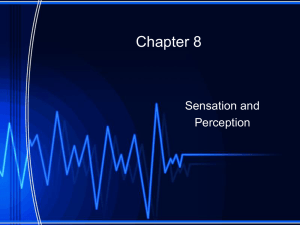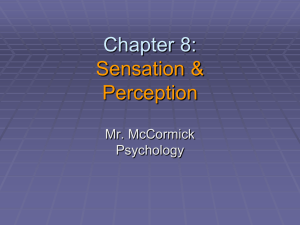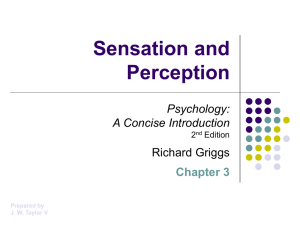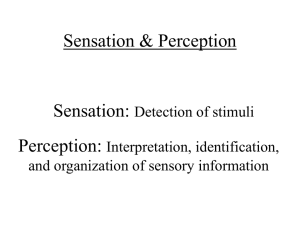Synesthesia Disorder in which the signals from the various sensory
advertisement
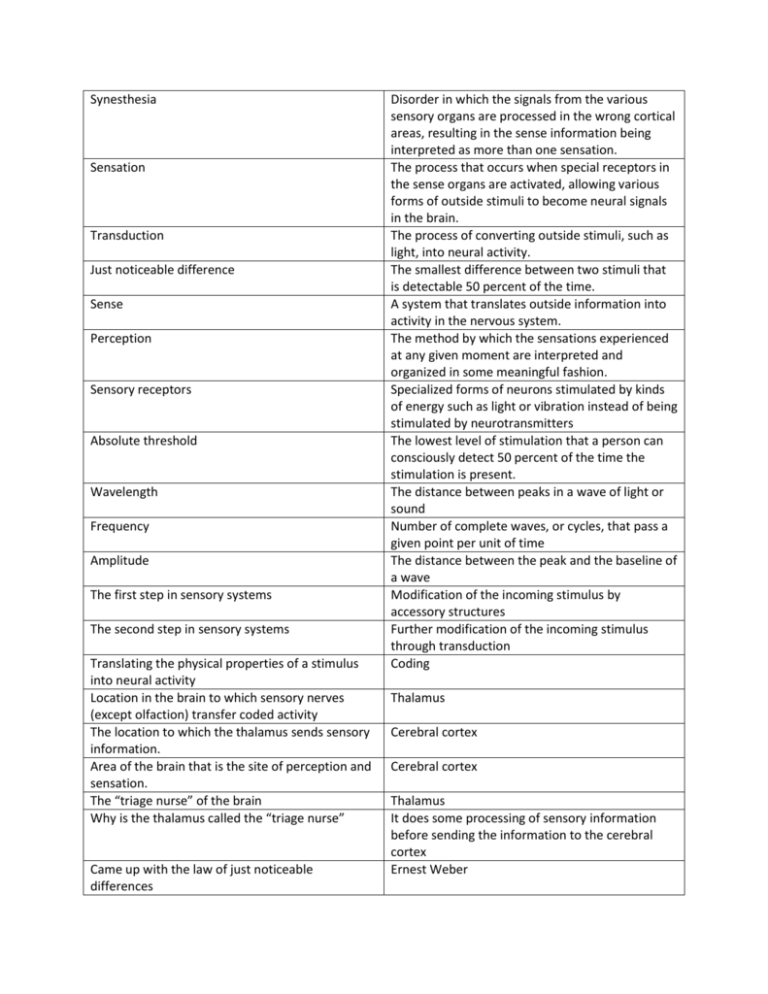
Synesthesia Sensation Transduction Just noticeable difference Sense Perception Sensory receptors Absolute threshold Wavelength Frequency Amplitude The first step in sensory systems The second step in sensory systems Translating the physical properties of a stimulus into neural activity Location in the brain to which sensory nerves (except olfaction) transfer coded activity The location to which the thalamus sends sensory information. Area of the brain that is the site of perception and sensation. The “triage nurse” of the brain Why is the thalamus called the “triage nurse” Came up with the law of just noticeable differences Disorder in which the signals from the various sensory organs are processed in the wrong cortical areas, resulting in the sense information being interpreted as more than one sensation. The process that occurs when special receptors in the sense organs are activated, allowing various forms of outside stimuli to become neural signals in the brain. The process of converting outside stimuli, such as light, into neural activity. The smallest difference between two stimuli that is detectable 50 percent of the time. A system that translates outside information into activity in the nervous system. The method by which the sensations experienced at any given moment are interpreted and organized in some meaningful fashion. Specialized forms of neurons stimulated by kinds of energy such as light or vibration instead of being stimulated by neurotransmitters The lowest level of stimulation that a person can consciously detect 50 percent of the time the stimulation is present. The distance between peaks in a wave of light or sound Number of complete waves, or cycles, that pass a given point per unit of time The distance between the peak and the baseline of a wave Modification of the incoming stimulus by accessory structures Further modification of the incoming stimulus through transduction Coding Thalamus Cerebral cortex Cerebral cortex Thalamus It does some processing of sensory information before sending the information to the cerebral cortex Ernest Weber Expanded on Ernest Weber’s work by studying absolute threshold Subliminal perception Subliminal perception and advertising What kind of stimuli is often perceived of subliminally Where in the brain is fear based stimuli perceived What area of the brain is responsible for filtering out constant stimuli during habituation Habituation Sensory adaptation Key point to remember about habituation Saccadic movement Photons Who first proposed that light is actually tiny packets of waves Three psychological principles of light Brightness Color (hue) What color do you get when you combine blue, red, and green light What is the visible spectrum Saturation The two sources of light are Cornea Procedure used to remove small portions of the cornea in order to change the curvature of the membrane and thereby improve focus Iris Gustav Fechner Perception of stimuli that are below the level of conscious awareness We do perceive sensory information subliminally but it does not influence our voluntary actions such as purchasing objects Stimuli that produces fear Amygdala Cerebellum The tendency of the brain to stop attending to constant, unchanging information Tendency of sensory receptor cells to become less responsive to a stimulus that is unchanging In habituation the sensory receptors are still responding to stimulation but the lower centers of the brain (cerebellum) are not sending the signals from those receptors to the cortex. The small movements made by the eyes that are generally not consciously noticed by individuals but that keep us from becoming adapted to visual sensory input Tiny particle packets of waves Albert Einstein Brightness; color; saturation Determined by amplitude of the wave Determined by length of wave White light The narrow band of light between 400nm and 700nm that is visible to the human eye The purity of the color people perceive with light. Light with only one wavelength would be highly saturated in that specific color. 1) Directly from the source, 2) indirectly as reflected off of a surface A clear membrane that covers the eye. It serves to protect the eye and bends light waves so the image can be focused on the retina. LASIK Round muscle of the eye Aqueous Humor Provides the color to the eye The round muscle of the eye Small hole in the Iris The image on the pupil is focused and manipulated by this A clear structure behind the Iris that is suspended by muscles and changes shape to bring objects into focus the change in the thickness of the lens as the eye focuses on objects that are far away Rods Cones Light sensitive area at the back of the eye containing three layers including the ganglion cells, bipolar cells, and photoreceptors The area of the retina that contains the greatest density of photoreceptors A type of interneuron that has a single dendrite at one end and a single axon at the other The axons of the retinal ganglion Blind spot Light from the left visual field falls on the ( ) side of each retina Light from the right visual field falls on the ( ) side of each retina Light from the left visual field falls on the right side of each retina and goes directly to the Light from the right visual filed falls on the left side of each retinal and goes directly to the Optic chiasm Light adaptation Dark adaptation Trichromatic theory The pathway that visual information takes to the occipital lobe Fluid filled layer behind the cornea that supplies nourishment to the eye Iris Iris Pupil The Iris Lens Visual accommodation Visual sensory receptors found at the back of the retina, responsible for non-color sensitivity to low levels of light Visual sensory receptors found at the back of the retina, responsible for color vision and sharpness of vision retina fovea Bipolar cell Optic nerve Area in the retina where the axons of three layers of retinal cells exit the eye to form the optic nerve, insensitive to light Right Left Right visual cortex Left visual cortex The crossover point of the visual information from the eyes to the brain The recovery of the eye’s sensitivity to visual stimuli in light after exposure to darkness The recovery of the eye’s sensitivity to visual stimuli in darkness after exposure to bright lights Theory of color vision that proposes three types of cones: red, blue, and green Lateral geniculate nucleus Color blindness Opponent-process theory Hertz (hz) Afterimages Sound Three properties of sound waves Wavelengths in sound are Amplitude in sound is Purity of sound is Limits of the human auditory spectrum Pinna Auditory canal Cochlea Auditory nerve Three bones of the middle ear Membrane of the inner ear Basilar membrane Organ of corti Pitch Place theory Frequency theory Volley principle Two types of hearing impairments A hearing impairment where sound vibrations cannot be passed from the eardrum to the cochlea A hearing impairment where the problem lies in the inner ear or the auditory pathways and cortical areas of the brain Vision that is color deficient due to having either no cones or cones that do not work properly Theory of color vision that proposes visual neurons are stimulated by light of one color and inhibited by light of another color Cycles or waves per second, a measurement of frequency Images that occur when a visual sensation persists for a brief time even after the original stimulus is removed Vibrations of the air molecules around us Wavelength, amplitude, purity Frequency or pitch volume Timbre or richness of tone 20Hz and 20,000 Hz The visible part of the ear Short tunnel that runs from the pinna to the eardrum Snail-shaped structure of the inner ear that is filled with fluid Bundle of axons from the hair cells in the inner ear Hammer (malleus), anvil (incus), stirrup (stapes) Oval window Membrane that runs down the middle of the cochlea The receptor cells for the sense of hearing found on the basilar membrane Psychological experience of sound that corresponds to the frequency of sound waves; higher frequencies are perceived as higher pitches Theory of pitch that states that different pitches are experienced by the stimulation of hair cells in different locations on the organ of Corti Theory of pitch that states that pitch is related to the speed of vibrations in the basilar membrane Theory of pitch that states that frequencies from about 400 Hz to 4000Hz cause the hair cells (auditory neurons) to fire in a volley pattern, or take turns in firing Conduction hearing impairment and nerve hearing impairment Conduction hearing impairment Nerve hearing impairment Hearing damage caused by a damaged eardrum or damage to the bones of the middle ear Treatment for conduction hearing impairments Hearing damage caused by exposure to loud noises Treatment for nerve hearing impairment The two chemical senses Gustation Olfaction Taste buds Bumps on the tongue Taste buds line the walls of the Five basic tastes Neurotransmitter that gives umami it’s brothy tastes Supertasters Food preference is impacted by True/false taste sensations are processed all over the tongue Olfactory bulbs Somesthetic senses Pacinian corpuscles Visceral pain Somatic pain Somatic pain is a signal of Skin senses Kinesthetic sense Vestibular sense Congenital analgesia Congenital insensitivity to pain with anhidrosis Phantom limb Gate-control theory Increase pain Conduction hearing impairment Hearing aids Nerve hearing impairment Cochlear implants Gustation and olfaction The sensation of taste The sensation of smell Common name for taste receptor cells Papillae Papillae Sweet, sour, salty, bitter, umami Glutamate People with greater than average numbers of taste buds Individual, cultural, genetic influences, weight. True Areas of the brain located just above the sinus cavity and just below the frontal lobes that receive information from the olfactory receptor cells The body senses consisting of the skin senses, the kinesthetic sense, and the vestibular senses Skin receptors that respond to pressure Pain detected by receptors in the organs Detected by receptors in the skin, muscles, tendons, and joints The body being damaged or about to be damaged The sensation of touch, pressure, temperature, and pain. Sense of the location of body parts in relation to the ground and each other The sensations of movement, balance, and body position Pain conditions where individuals cannot feel pain Disorder where individuals do not feel pain and also cannot sweat Condition where a person can still feel pain in a limb that has been amputated Theory of pain where a chemical substance for pain is released into the spinal cord and passes through a gate on the way to the brain. The brain then sends a reverse message either further opening the gate or closing the gate. Anxiety, fear, helplessness Decreases pain Otolith organs Semicircular canals Sensory conflict theory Perception Size constancy Shape constancy Brightness constancy Figure-ground Reversible figures Proximity Similarity Closure Continuity Contiguity Depth perception Monocular cues Linear perspective Binocular cues Overlap Laughter, distraction, sense of control, competing signals from other senses Tiny sacs of gelatin fluid and tiny crystals found just above the cochlea that help to tell a person the location of their head in relationship to their body and movement Three somewhat circular tubes that coordinate with a specific plane of body movement An explanation of motion sickness in which the information from the eyes conflicts with the information from the vestibular senses, resulting in dizziness, nausea and other physical discomfort. The methods by which the sensations experienced at any given moment are interpreted and organized in some meaningful fashion The tendency to interpret an object as always being the same actual size, regardless of distance The tendency to interpret the shape of an object as being constant, even when its shape changes on the retina The tendency to perceive the apparent brightness of an object as the same even when the light conditions change The tendency to perceive objects, or figures, as existing on a background Visual illusions in which the figure and ground can be reversed The tendency to perceive objects that are close to each other as part of the same grouping The tendency to perceive things that look similar to each other as being part of the same group The tendency to complete figures that are incomplete The tendency to perceive things as simply as possible with a continuous pattern rather than with a complex broken-up pattern The tendency to perceive two things that happen close together in time as being related The ability to perceive the world in three dimensions Cues for perceiving depth based on one eye only The tendency for parallel lines to appear to converge on each other Cues for perceiving depth based on both eyes The assumption that an object appears to be blocking part of another object is in front of the second object and closer to the viewer Aerial perspective Texture gradient Relative size Motion parallax Accommodation Convergence Binocular disparity Perceptual set Top-down processing Bottom-up processing Synesthesia The haziness that surrounds objects that are farther away from the viewer, causing the distance to be perceived as greater. The tendency for textured surfaces to appear to become smaller and finer as distance from the viewer increases Perception that occurs when objects that a person expects to be of a certain size appear to be small and are, therefore, assumed to be much farther away The perception of motion of objects in which close objects appear to move more quickly than objects that are farther away As a monocular cue, the brain’s use of information about the changing thickness of the lens of the eye in response to looking at objects that are close or far away. The rotation of the two eyes in their sockets to focus on a single object, resulting in greater convergence for closer objects and lesser convergence if objects are distant. The difference in images between the two eyes, which is greater for objects that are close and smaller for distant objects The tendency to perceive things a certain way because of previous experiences or expectations influence those perceptions The use of preexisting knowledge to organize individual features into a unified whole The analysis of the smaller features to build up to a complete perception Disorder in which the signals from various sensory organs are processed in the wrong cortical areas, resulting in the sense information being interpreted as more than one sensation



